Cooling Coil (Evaporator Coil) Basics for Air Conditioning & Heat Pump Systems
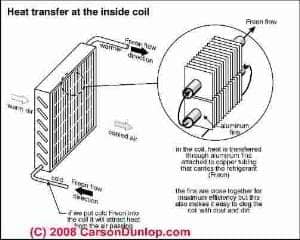 If your air conditioning or heat pump system has lost its cooling capacity or won't start see REPAIR GUIDE for AIR CONDITIONERS.
If your air conditioning or heat pump system has lost its cooling capacity or won't start see REPAIR GUIDE for AIR CONDITIONERS.
See How to determine the cooling capacity of air conditioning equipment if the system seems to be working but is inadequate to cool your building.
Contact us to suggest text changes and additions and, if you wish, to receive online listing and credit for that contribution. Page top photo of an iced-up air conditioning evaporator coil are courtesy Guy Benfante.
The cooling coil or evaporator coil is where building indoor air cooling actually takes place.
The liquid air conditioning refrigerant entering the cooling coil through the metering device (a capillary tube or THERMOSTATIC EXPANSION VALVE) is increasingly changed to gas form as it "boils" or evaporates as the liquid refrigerant flows through the cooling or "evaporator" coil, so that at the end of the cooling coil the refrigerant is totally in gaseous form.
This state change (liquid to gas refrigerant) absorbs energy, cooling the tubing and fins of the cooling coil and thus indirectly, cooling and dehumidifying indoor air that is blown across the coil.
A cooling coil which is blocked by debris or ice and frost, or which is damaged can obstruct air flow and reduce air conditioning system output. The air conditioning system evaporator coil and problems include ice and frost build-up, dirt or debris blocking air flow through the coil, and damaged or leaky cooling coils.
We also discuss how cooling coils may be cleaned in-place and what to watch out for during that procedure. Cooling coils which are part of an air conditioning retrofit installation onto an existing warm air heating system can also present special problems of sizing and air flow, discussed further at ADDING A/C: RETROFIT SIZING. Sketch of heat transfer at the inside coil, also called the cooling coil or evaporator coil, courtesy of Carson Dunlop Associates.
If ice, dirt, or damage block air flow across or through the cooling coil (evaporator coil) in an air conditioner, the cool air output will be substantially reduced or may even stop entirely.
Below we describe how the cooling coil works, what goes wrong with this component, and how its problems are diagnosed by simple visual inspection (inside of the air handler) or by some simple temperature measurements.
How To Inspect, Test, & Diagnose Cooling Coil (Evaporator Coil) Air Conditioner or Heat Pump Problems
First, make a visual inspection of the cooling coil. Most air handlers provide an access panel or cover that can be removed to give at least partial view of the cooling coil surfaces.
Turn off electrical power to the system to be safe from electrical shock.
On opening an access cover or panel on the air handler you can recognize the cooling coil from our photos and sketches shown here and elsewhere on this website. You may need to use a flashlight and mirror to see the coil surfaces.
Remember to inspect the cooling coil from the incoming-air side - the side of the coil facing the blower fan assembly. That's because any dirt or debris entering the coil will come principally from this direction. If you inspect the wrong side of the coil it may look perfectly clean even though it is totally blocked by debris on its other surface.
DIRTY COOLING COIL has photos of just how blocked a cooling coil can become in an air conditioner or heat pump.
Here are some common defects to look for at the evaporator coil (cooling coil) in an air conditioner or heat pump:
- Dirt or debris blocking air flow through the coil (DIRTY COOLING COIL)
- Ice or frost formation blocking air flow through the coil (FROST BUILD-UP on AIR CONDITIONER COILS)
- Damaged cooling / evaporator coil fins over more than 10% of the coil surface, blocking air flow (shown in our photo at left in this case, the damage is to a condensing coil, not an evaporator coil). Small areas of damaged cooling fins can be straightened and cleaned-up using a cooling coil comb. Cooling coils with extensive physical damage such as shown in our photograph need to be replaced.
- Evidence of refrigerant leaks (visual evidence may include stains from refrigerant oil left at the point of leakage) (REFRIGERANT LEAK DETECTION)
- Evidence of mold growth on organic debris on the coil or elsewhere in the blower compartment (Mold Growth in Air Handlers)
- Presence of unusual materials on the coil surface such as rodent debris, bird feathers and debris, fiberglass insulation, large trash fragments like paper or leaves confirming a duct or air filter problem. Some of these may indicate potentially serious health risks such as rodent or bird feces and debris which risk bacterial and viral hazards in building air. (Leaks, Rodents In Air Handlers)
- Obvious coil-to-air-handler size mismatch of an add-on cooling coil onto an existing warm air system (ADDING A/C: RETROFIT SIZING)
- Evaporator coil or cooling leaks or holes: if an evaporator coil is leaking (or also if the condensing coil is leaking) you'll find out pretty quickly as refrigerant will be lost and the cooling system will stop providing cool air. You'll need expert diagnosis by an HVAC service technician.
- A lot depends on where the refrigerant leak has occurred and what caused the leak. If the cooling coil has a single point leak caused by some mechanical damage (one of our readers accidentally drilled a hole in his coil while trying to drill a drain hole in his air handler), it may be possible to find the hole and repair it using silver solder.
- If the refrigerant leak is in copper tubing anywhere in the cooling or heat pump system that is not too close to an evaporator coil or condensing coil, it should be possible to solder a repair, then evacuate and recharge the cooling system.
- If the refrigerant leak is in copper tubing in or close to the cooling coil (or in a condensing coil) a solder repair is hard to complete because the heat of the soldering process tends to de-solder other nearby connections. It might be possible if the technician is very expert and if s/he knows how to keep nearby surfaces cooled (we've used a wet rag).
- If the refrigerant leak is in an aluminum part, soldering aluminum is more tricky and may not be feasible. Ordinary procedures using a torch, for example, just melt the aluminum. Expert welders use inert gas welding methods.
- If the refrigerant leak is due to severe corrosion anywhere in an HVAC system we're not optimistic that a solder repair is possible. The conditions that caused a corrosion-related leak are likely to have thinned and weakened other parts. The cost of an attempted repair may be wasted.
- Replacement of the cooling coil (or condensing coil) is more often going to be recommended by your HVAC technician because of these difficulties.
Temperature measurements at the cooling coil: see OPERATING TEMPERATURES for a discussion of where and how air temperature measurements are made to diagnose cooling coil or other air conditioner operating problems.
Below we introduce some of the more common air conditioner or heat pump cooling coil or evaporator coil defects and repairs.
Air flow requirements across the air conditioning evaporator coil: if airflow is weak for any reason (dirty coil, duct system defects, blower fan defects, dirty blower squirrel cage fan), the air conditioning system will not operate properly. Some experts write that there should be between 350 and 400 cubic feet of air per minute (CFM) moving across the evaporator (cooling) coil for each ton of air conditioner capacity.
One ton of cooling or heating capacity = 12,000 BTUH so if your AC unit or heat pump is a 24,000 BTUH unit it is a "two ton" unit and needs to see 700 to 800 CFM of air across the evaporator coil.
Some home inspectors and air conditioning service technicians carry a small airflow meter that can actually measure this number with fair accuracy. (The same tool is nice for comparing air flow and balancing air flow at various building supply ducts and registers.
How Air Conditioning & Heat Pump Evaporator Coils (Cooling coils) are Cleaned
Evaporator coil cleaning often requires cutting refrigerant lines, removal of the coil and other components for cleaning, and reinstallation, pulling a vacuum on the refrigerant lines, and recharge with refrigerant. Such service and repair may involve significant expense, although there are some "in place" cleaning methods using foams and sprays that are a simpler procedure. See DIRTY COIL CLEANING PROCEDURES for details of this topic.
FROST BUILD-UP - Frost Build-up on the Evaporator Coil in an Air Conditioner
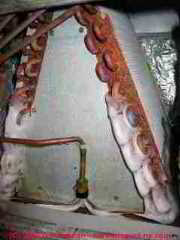 The ice or frost formed on a cooling coil in an air conditioner air handler unit is usually caused by an improper refrigerant charge, possibly by inadequate air flow across the cooling coil, or by a thermostatic expansion valve (TEV) or other air conditioner or heat pump control defect.
The ice or frost formed on a cooling coil in an air conditioner air handler unit is usually caused by an improper refrigerant charge, possibly by inadequate air flow across the cooling coil, or by a thermostatic expansion valve (TEV) or other air conditioner or heat pump control defect.
Ice blocks air flow through the coil, thus reducing air conditioner output; if the ice formation is extreme nearly all of the airflow across the coil is blocked and the air conditioner system runs but does not produce cool air flowing into the occupied space.
Frost and ice can also form on refrigerant tubing at other locations, and frost and ice can form inside air conditioning duct work itself, leading to troublesome leaks into the building.
Details of what causes frost on air conditioning equipment, what problems that creates, and how to diagnose and repair icing or frost on cooling coils or other air conditioner parts are provided at FROST BUILD-UP on AIR CONDITIONER COILS. TThis article explains locations and causes of condensate, frost or ice formation in air conditioning systems, air handlers, compressor/condensers, refrigerant lines, and in air ducts.
Note that frost formation at some cooling coils (not air conditioners or dehumidifiers) may be normal. We discuss frosting and non-frosting cooling coil types and coil defrosting methods further at Frosting vs. Non-Frosting Types of Evaporator Coils
BLOCKED COOLING COIL - Air Conditioner Evaporator Coil Blocked by Debris or Dirt
 Ice is not the only (nor even the most common) cause of blocked air flow in an air conditioner. This photograph shows how easily debris can stick to and clog the inlet side of the cooling coil in an air conditioning system. This evaporator coil was nearly totally blocked with dust and debris. How does this happen?
Ice is not the only (nor even the most common) cause of blocked air flow in an air conditioner. This photograph shows how easily debris can stick to and clog the inlet side of the cooling coil in an air conditioning system. This evaporator coil was nearly totally blocked with dust and debris. How does this happen?
There was no air filter installed in the system. Ordinary house dust is comprised largely of fabric fibers and skin cells.
These and other debris in building dust such as soot and organic particles like pollen and mold spores all join to form a gray mat on the fins of the cooling coil in an air handler.
Debris sticks particularly quickly to this surface because of the combination of close spacing of the cooling fins (about 1/16" apart) and the fact that condensate forming on the coil keeps the surface damp.
Details about the detection and cleaning of dirt and debris which block an air conditioner cooling coil are at DIRTY COOLING COIL.
Types of Evaporators or Evaporator Coils or Cooling Coils: Dry vs Flooded Evaporator Coil Designs
Dry Evaporator Coils: in a dry evaporator coil design, all of the refrigerant entering the evaporator coil enters as a vapor (or gas).
In a dry type evaporator coil (or cooling coil) the refrigerant oil travels constantly in the system along with the refrigerant, and some oil is discharged into the condenser. That is, only liquid refrigerant can actually carry oil.
In the evaporator the refrigerant is vaporized and the oil travels through, but the vapor is less capable of actually carrying the oil through the coil.
For the oil to pass through we need refrigerant gas velocity and turbulence in the evaporator coil, so we do not want much pressure drop across the evaporator coil.
Therefore dry evaporator type coils are usually short - to avoid much pressure drop.
Otherwise we get oil traps at the bends in the evaporator coil.
These are the more common type of evaporator coil or cooling coil in refrigeration systems. So, for example, for a small air conditioner that has to be packed into a small space, to keep the evaporator length short the manifold system may used to run several short evaporator loops in parallel - to avoid long individual tubing runs that might cause an ensuing refrigerant pressure drop and oil traps in the system.
[An oil trap will clog or prevent refrigerant flow through the evaporator and thus will prevent the system from working. A symptom might be loss of cooling and high refrigerant pressures on the high side]
Flooded Evaporator Coils: in a flooded evaporator coil design, the evaporator is constantly full of refrigerant, whether the cooling system is "on" or "off". See our cooling coil sketches shown here.
Frosting vs. Non-Frosting Types of Evaporator Coils
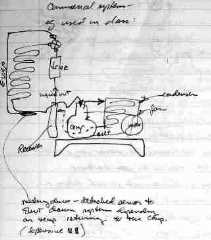 Our sketch (left) shows the basic layout of a commercial refrigeration system. Here we detail the difference between frosting and non-frosting evaporator coils and we explain how frosting-type systems must be defrosted to keep working.
Our sketch (left) shows the basic layout of a commercial refrigeration system. Here we detail the difference between frosting and non-frosting evaporator coils and we explain how frosting-type systems must be defrosted to keep working.Non-Frosting Evaporator or Cooling Coils - No Defrosting Needed
Dehumidifiers are examples of non-frosting type cooling coil designs. These devices are basically little "air conditioners" or cooling systems in their design (though their warm air output is exhausted directly into the same space). The dehumidifier system is a refrigeration system designed such that the coil will never form ice or frost.
Room air conditioners (portable or window or through wall units) are also examples of non-frosting type cooling coil designs.
These "frost-proof" or non-frosting systems (in normal operation) ar more difficult to charge: you must use a precisely measured charge or a temperature-sensing device and matching gauge with the temperature-sensing device - you find where the liquid ends in the evaporator line - where there is no further change in temperature in the evaporator coil tubing, there is no more liquid refrigerant present.
If you see ice or frost on these cooling coils it's an abnormal condition that needs to be diagnosed and repaired. See our diagnostic advice at FROST BUILD-UP on AIR CONDITIONER COILS
Defrosting Methods for Cooling Coils (Evaporator Coils) in Refrigeration Systems
Frosting Evaporator or Cooling Coils Require a Defrost Cycle
Examples of frosting evaporator coils or cooling coils include refrigerators (or freezers). When more than 1/4 of the surface is ice or frost that condition acts as an insulator that reduces the efficiency of the appliance, so the appliance will have to defrost itself - either automatically or manually.
There are two defrosting methods commonly used in frosting-evaporator coil designs:
Defrost by electrical resistance heating (common on refrigerators, including frost-resistance for door faces and jambs using extra resistance heating elements in those areas too);
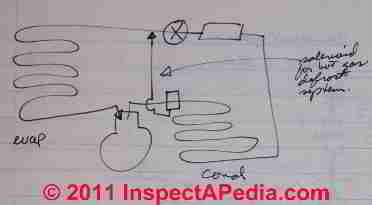 Defrost by hot gas: a solenoid in the compressor discharge line shuts [sketch above left] down vapor from the condenser and deposits high pressure/high temperature refrigerant gas directly into the evaporator coil, bypassing the refrigerant metering valve (TEV or cap tube).
Defrost by hot gas: a solenoid in the compressor discharge line shuts [sketch above left] down vapor from the condenser and deposits high pressure/high temperature refrigerant gas directly into the evaporator coil, bypassing the refrigerant metering valve (TEV or cap tube).
The problem with dumping high temperature refrigerant vapor into the cold (iced, needs defrosting) evaporator is that it causes it to begin to condense - back pressure of the gas goes up and head pressure at the condenser goes down - now liquid refrigerant can back up to the compressor (where it would cause damage).
To avoid compressor damage from liquid refrigerant during this defrost cycle we add heat at the end of the evaporator coil (cooling coil) to insure that refrigerant reenters the compressor as a vapor, never as a liquid. Typically, setting a maximum of 20 minutes of defrost cycle adds protection against warming up food in the refrigerator or freezer where this design is used.
The refrigeration compressor continues to run during the defrost cycle in the hot gas method case, but the compressor will not keep running during the defrost cycle in the electrical resistance defrost cycle method.
When is cooling coil frosting abnormal?
Note that on dehumidifiers and air conditioners or heat pumps frost or ice formation on the cooling coil is not normal and is an indication of the need for repairs. See our diagnostic advice at FROST BUILD-UP on AIR CONDITIONER COILS
How cooling coils are changed-out or replaced
When an evaporator coil or cooling coil needs replacement (perhaps because the old one is damaged or leaky):
- Because replacing a cooling coil or evaporator coil is a lot of work (and costly) first see if the old coil can be preserved. Combs can straighten out damaged cooling coil fins if they are not corroded too badly; and special expoxies are available to seal punched holes - a moderately successful repair attempt. If the coil is leaking due to corrosion, epoxy is probably a waste of time - replace the coil.
- The new cooling coil must be the same size as the old one it replaces in order to keep the system in balance.
- A short copper line is connected to the coil (at the factory) - use a wet rag or a flare block as a heat sink to avoid putting excess heat on this copper line (which may be connected to an aluminum coil by epoxy) during soldering the new evaporator coil to the existing refrigerant supply and suction lines.
- On newer HVAC and refrigeration systems you will usually have to cut out the old coil in place, removing both the coil and the foam poured around it. On older systems there may be screws and an access panel, usually on the freezer side of the coil in that equipment.
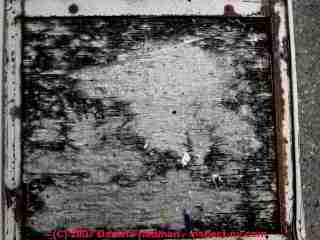
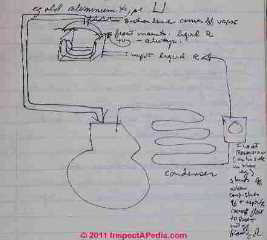
A good air conditioning system has everything required to help filter out particles of dust before fresh air is passed throughout the home. Dust carries pollen and other allergens, so this filtration system is a necessary part of maintaining good health for the entire family, for more information click here ac maintenance coral gables.
ReplyDeleteThis is excellent information. It is amazing and wonderful to visit your site.Thanks for sharing this information,this is useful to me AC coil cleaning San Antonio
ReplyDeleteGreat read! Choosing a reliable AC installation service in Dubai can greatly improve comfort, energy efficiency, and long-term reliability. I appreciate how this article breaks down the process and provides clear, practical tips for a successful installation.
ReplyDelete